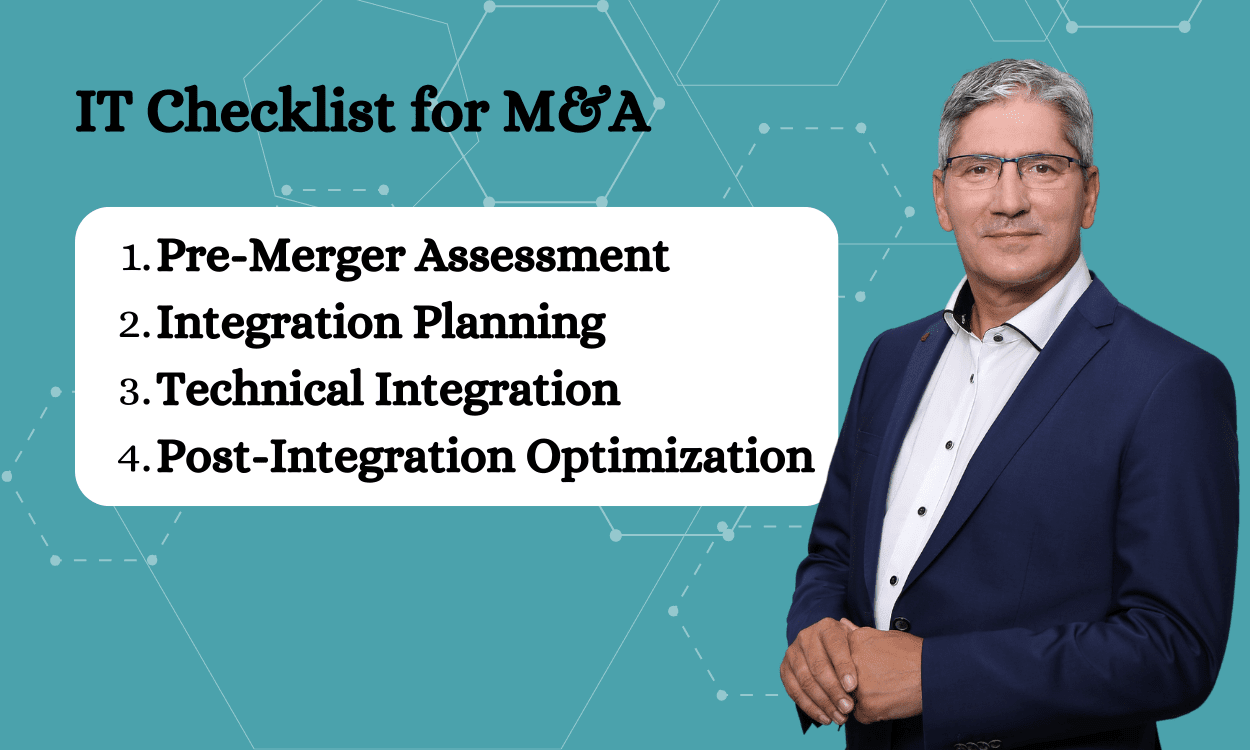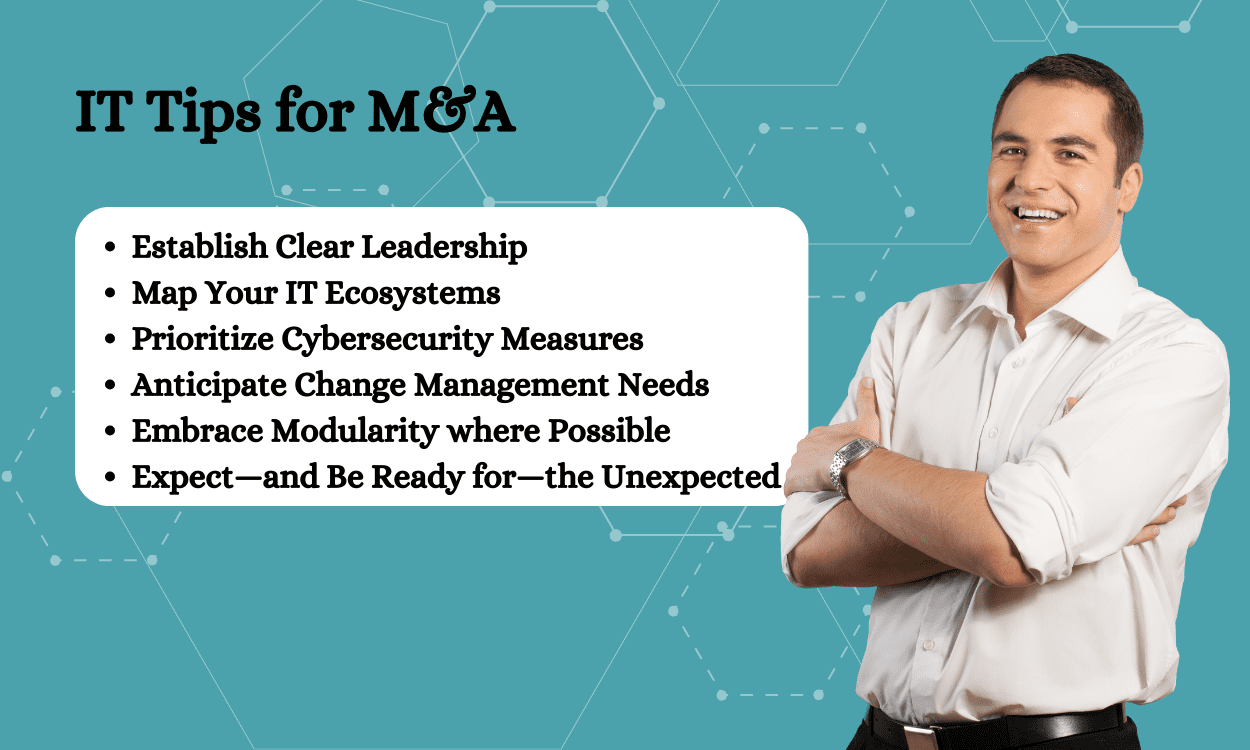
Imagine two giants in a tango, each with its own rhythm and steps; that’s the dance of mergers and acquisitions (M&As). When companies merge, it is not just a financial transaction, but a blending of cultures, processes, and critically, information technology systems. The role IT plays in this dance can make or break the performance. Amidst the whirlwind of legalities and financial strategies lies the backbone of modern business: technology.
It’s in this technological arena where many M&A ambitions either soar to new heights or face unexpected stumbling blocks. Navigating this digital landscape requires careful planning and execution. I’ve been through the trenches of M&A activities, seen the pitfalls, and celebrated the triumphs.


The Role of IT in M&As
When it comes to mergers and acquisitions (M&A), the pivotal role that IT plays cannot be underestimated. At its core, the process of combining two entities or swallowing an asset is intricate, with a huge dependency on technology to enable seamless integration between them. That being said, let’s delve into the significance of IT during M&A transactions.
IT Due Diligence
Firstly, understanding that due diligence goes beyond the financials is fundamental; an essential part lies in assessing the IT capabilities of both parties involved in IT mergers and acquisitions. This step ensures compatibility or highlights areas necessitating significant upgrades or alignments.
IT Framework
A well-structured IT framework can serve as a backbone for decision-making processes, offering insights and navigating trade-offs that help avoid costly overruns or pitfalls associated with merging technical infrastructures. Data from various systems must be consolidated while ensuring regulatory compliance and without compromising sensitive information.
Technology
Lastly, technology serves as an enabler of corporate strategy post-M&A. A clearly articulated IT vision can significantly expedite harmonization across merged organizations. It does so by establishing uniform processes, investing in scalable platforms and fostering a culture agile enough to adjust to the new business environment. When performed correctly, the strategic involvement of IT immensely contributes to achieving the anticipated benefits from it m&a initiatives.
Without question, ignoring IT alignment in M&As could lead to potential disasters – integration issues later on down the line can prove difficult and expensive to resolve. Hence why prioritizing IT considerations early in a merger or acquisition is more than just good practice—it’s crucial for ensuring long-term success.

IT Checklist for Mergers & Acquisitions
Navigating the complex terrain of mergers and acquisitions (M&As) is no small feat, particularly when it comes to unifying the information technology (IT) that serves as the backbone of modern businesses. To help guide you through this intricate process, I’ve curated a comprehensive IT checklist tailored to ensure your M&A venture is smooth, well-planned, and ultimately successful.
Now, let’s review that checklist.

1. Pre-Merger Assessment
Infrastructure Evaluation
Begin by analyzing the existing IT infrastructure of both entities. Scrutinize network architecture, hardware status, software licenses, support contracts and compatibility. You’re on the hunt for redundancies and potential conflicts. It’s akin to untangling a set of deeply knotted wires—tedious but necessary.
- Assess and Inventory physical and digital assets.
- Appraise current software solutions.
- Identify duplicates in capabilities or services.
- Review compatibility between systems.
Data Security Audit
Your data security must be impermeable. Conduct thorough audits on cybersecurity practices, including firewalls, encryption measures, and intrusion detection systems from both parties involved in the merger.
- Evaluate existing security protocols.
- Check compliance with relevant regulations (GDPR, HIPAA, SOX).
- Identify gaps requiring immediate action post-M&A.
IT Talent Assessment
People fuel your infrastructure just as much as hardware does; analyze each entity’s IT team skills matrix critically. Pinpoint areas where training may be needed or where new talent may have to be outsourced. Identify any overlap for any incoming employees and help chart the path forward for merging of the teams.
2. Integration Planning
Strategic Roadmap
The journey ahead needs a map—your strategic roadmap will chart out how you integrate two distinct technical operations into one cohesive unit without disrupting business operations significantly.
- Set up a governance process and Integration Management Office.
- Outline critical milestones.
- Stipulate resource allocations across teams.
- Synchronize integration efforts with business goals and timelines.
Communication Strategy
No room for whispers here; clear communication is vital during a transition period fraught with potential misunderstandings and resistance to change among staff.
- Establish regular updates for stakeholders at all levels.
- Use diverse communication platforms to ensure reachability.
- Encourage open lines for feedback throughout integration phases.
- Organize types of issues into a RAID (Risks, Actions, Issues, Decisions) log and track individually; assign ownership to resolve.
3. Technical Integration
Data Migration
You’re essentially moving digital lives from one home to another—it has to be methodical and secure so that no ‘belongings’ get lost or damaged in transit.
- Utilize Change Management and plan meticulously before execution.
- Implement role-based access controls during migration processes to maintain data integrity.
- Test backups extensively beforehand.
Unified Systems
Combining different technologies means achieving harmony within your newly created ecosystem; this involves streamlining applications and platforms into workable unified systems that ideally improve upon pre-existing functionality while trimming down superfluous elements where possible.
- Consolidate overlapping tools and platforms effectively.
- Choose integrations lending towards scalability and adaptability against future tech evolutions or company growths.
Testing Protocols
Nothing can go live without rigorous testing! This stage might make or break your entire integration attempt due to unforeseen technical woes and compromised data accuracy if underestimated or rushed.
- Conduct exhaustive system tests at various levels – unit testing, integration testing, performance testing.
- Deploy User Acceptance Testing (UAT) involving end-users helps discover real-world issues bypassed in simulations.
4. Post-Integration Optimization
Hypercare and Performance Monitoring
After investing considerable time blending two IT ecosystems together post-M&A celebration isn’t yet due—you’ll need gauges measuring system health consistently identifying opportunities for further optimization tweaking as operational realities evolve.
- Provide dedicated resources to support post-integration issues and challenges. Triage major issues using a ticketing system and assign resources to rapidly handle root causes. Have management help identify priority resolutions and run point in communication so engineers can do their jobs.
- Track key performance indicators (KPIs) relevant toward system efficiencies service uptimes – these metrics ultimately reflect customer/employee experience quality assure that peak performance remains non-negotiable priority regardless shifts demands internally externally
Training and Support
Lastly equip empower people handling driving novel machinery Solid training support provide bedrock upon which unhindered productivity flourishes ensure not only trained proficiently also strategically supported should they face hiccups along road ahead
- Roll-Out extensive cross-training programs inclusive legacy new tools acquired from merger
- Offer steadfast user support channels dedicated prop up novice seasoned users alike midst evolving landscapes

IT Tips for Successful Mergers & Acquisitions
Navigating the complexities of merging two companies can feel akin to solving a multidimensional puzzle. Information Technology (IT) plays a vital role in ensuring the pieces fit together smoothly. For merging enterprises looking to thrive, there’s no substitute for meticulous planning and execution in IT. To aid you on this journey here are some critical tips—think of this as your insider’s guide to IT harmony during mergers and acquisitions.
First and foremost, keep in mind that communication is king. From the get-go, make sure all stakeholders have clarity about their roles and responsibilities during the merger process. This prevents overlap of duties and reduces friction between teams.
Moving forward, let me emphasize how crucial it is to carefully construct an acquisition integration checklist. This tool will help you navigate through the labyrinth of technical details with precision:
- Establish Clear Leadership: Appoint leaders who bring robust tech acumen alongside a trait that often goes unmentioned yet remains invaluable—empathy. They should be able to not only understand but also relate to the concerns of different teams across both organizations.
- Map Your IT Ecosystems: Make an exhaustive inventory of all systems, applications, databases, and hardware within both entities. By mapping these out, you ensure no critical component slips through the cracks during consolidation.
- Prioritize Cybersecurity Measures: Security shouldn’t take a back seat amidst all changes; if anything it needs extra attention during such times when systems are most vulnerable. Craft stringent cybersecurity protocols early on by constructing a merger checklist integration that revolves around security postures and compliance benchmarks.
- Anticipate Change Management Needs: A merger or acquisition isn’t just about combining technologies; it involves melding cultures too. Anticipate human reactions to changes—whether reluctance or confusion—and tailor training programs that assist employees in transitioning comfortably into new workflows.
- Embrace Modularity where Possible: Approaching your technological merge with modularity in mind can soften potentially disruptive transitions by allowing systems from different companies to communicate without requiring complete overhauls immediately.
- Expect—and Be Ready for—the Unexpected: No matter how perfect your integration checklist for merger seems, unforeseen challenges will arise. Maintain agility when pivoting strategies become necessary and keep contingency plans ready at hand.
In summary:
- Ensure clear stakeholder communication
- Develop a detailed acquisition integration checklist
- Appoint empathetic yet technically savvy leadership
- Comprehensively map all technological assets
- Uphold stringent cybersecurity standards throughout
- Consider change management practices beforehand
- Adopt modular approaches toward system integration
- Prepare contingently for unpredictable scenarios
By incorporating these suggestions into your merging two companies checklist, you enhance not just the likelihood of success but also position yourself as an organization equipped to deal with post-merger landscapes deftly—and that’s a winning formula worth pursuing.
Need Some Cyber Support?
Conclusion
Navigating through a merger or acquisition can often feel like steering a ship through stormy waters. The role of IT in this journey, chock-full of complex challenges, is akin to the mainsail – pivotal and empowering, guiding the organization to emerge stronger post-merger. As we’ve explored together, assembling a meticulous IT checklist not only provides clarity but ensures that essential technical elements are addressed with precision and foresight.

